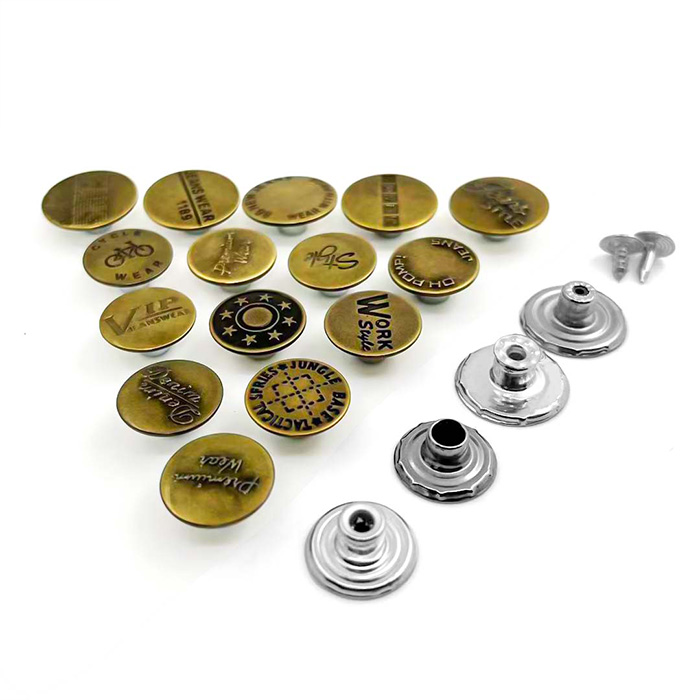The process of assembling metal buttons is intricate and typically involves several steps to ensure the button’s sturdiness, appearance, and functionality. Metal buttons usually consist of components such as the metal shell, inner core, back cover, and other parts, all of which must be combined properly. Below are the main steps involved in assembling metal buttons:

1. Material Selection and Preparation
The materials used for making metal buttons typically include:
- Metal Shell: Common metals include copper, aluminum, stainless steel, or zinc alloy. Depending on the design, the metal shell may undergo electroplating (e.g., gold, silver, chrome plating) to enhance its appearance.
- Button Inner Core: Some metal buttons include an inner core (made of plastic or alloy) to add strength or reduce the weight of the button.
- Back Cover: The back cover, also typically made of metal, is used to secure the shell and button components together.
- Buttonhole: Some metal buttons are designed with specific buttonholes or other fastening structures for attachment to clothing.
2. Shaping the Outer Shell
- Stamping/Die Casting: The metal shell is typically made using stamping, die-casting, or molding processes. Through these processes, metal sheets are cut and formed into the shape of the button shell. Decorative elements like engraving, cutouts, or patterns can be added to the shell.
- Surface Treatment: After the shell is formed, it may undergo surface treatments such as polishing, spray painting, sandblasting, and electroplating to improve its appearance and durability. Electroplating is a common method that makes metal buttons shiny and enhances their corrosion resistance.
3. Punching Holes or Buttonholes
Punching holes is a critical step in the manufacturing of metal buttons, especially for those with buttonholes or threaded holes:
- Punching Buttonholes: Holes for buttoning are punched at the center of the button to allow them to fit through the buttonholes of garments. This process is carried out using precise stamping equipment to ensure the hole is the right size and location.
- Threaded Holes: For certain metal buttons (such as those requiring screws or nuts), threaded holes may be added to the button shell to facilitate fastening to clothing or other accessories.
4. Assembly of Inner Core and Back Cover
- Attaching the Inner Core: For more robust metal buttons, especially those used in uniforms or workwear, the inner core may be secured inside the metal shell either manually or using machinery. This inner core adds stability and durability to the button.
- Attaching the Back Cover: The back cover is an essential component for holding the front and back parts of the button together. It is usually attached using one of the following methods:
- Press Fitting: The back cover is pressed onto the button shell using mechanical pressure to ensure a firm fit.
- Welding: For some specialized metal buttons, welding may be used to permanently attach the back cover to the shell.
5. Quality Inspection
After assembly, each metal button undergoes strict quality inspection:
- Visual Inspection: The button is checked for surface imperfections such as scratches, bubbles, peeling paint, or other defects.
- Firmness Test: It is essential to ensure that the outer shell and back cover are securely connected and that the button will not come apart easily.
- Functionality Test: The buttonholes are tested to ensure they are smooth, properly aligned, and able to easily fit through the buttonholes on garments.
6. Decorative Treatments (if applicable)
Some high-end metal buttons undergo additional decorative treatments after the basic assembly is completed:
- Engraving or Laser Etching: Some metal buttons are engraved with logos, patterns, or special designs to enhance their aesthetic appeal.
- Embedding Decorative Elements: Buttons may also feature embedded jewelry, gemstones, or other decorative elements to elevate their overall appearance.
7. Packaging and Shipping
After assembly and quality inspection, the metal buttons are packaged for shipment. Depending on customer requirements, metal buttons may be sorted by size, color, material, and other characteristics. Packaging is usually done in small bags, boxes, or bulk packs for easy transportation, storage, and retail sale.

